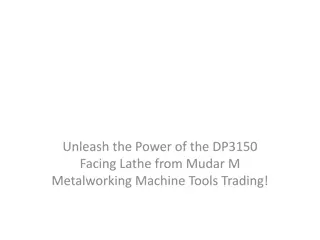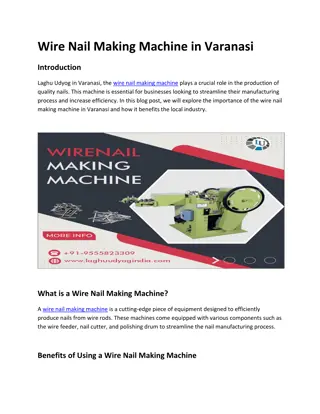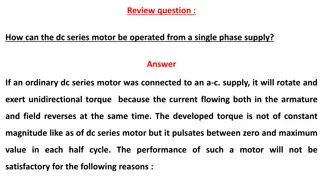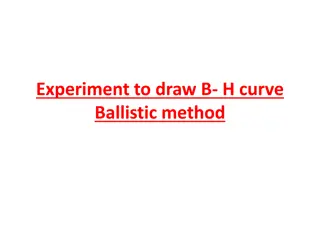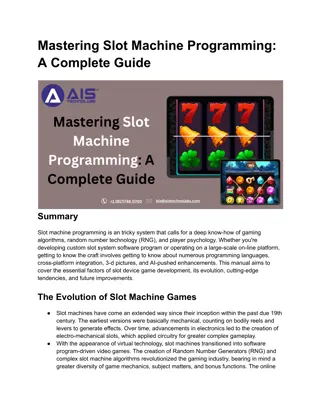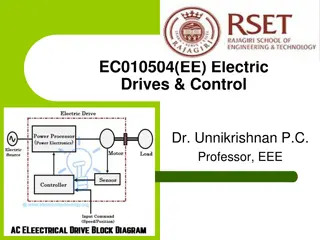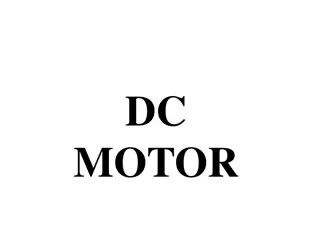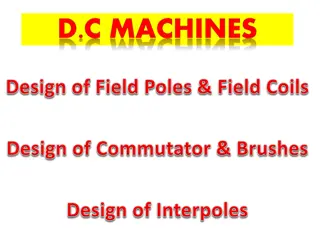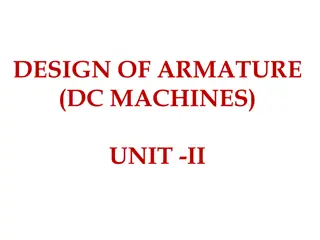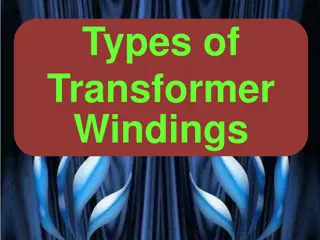DC Machine Armature Windings Overview
Learn about the construction and types of armature windings in DC machines, including lap wound and wave wound armatures. Discover how lap wound armatures are suitable for low voltage, high current applications, while wave wound armatures are used in high voltage, low current scenarios. Understand the principles of voltage and torque generation in armature coils. Explore the differences between lap wound and wave wound configurations and their applications in different types of machines.
Download Presentation

Please find below an Image/Link to download the presentation.
The content on the website is provided AS IS for your information and personal use only. It may not be sold, licensed, or shared on other websites without obtaining consent from the author.If you encounter any issues during the download, it is possible that the publisher has removed the file from their server.
You are allowed to download the files provided on this website for personal or commercial use, subject to the condition that they are used lawfully. All files are the property of their respective owners.
The content on the website is provided AS IS for your information and personal use only. It may not be sold, licensed, or shared on other websites without obtaining consent from the author.
E N D
Presentation Transcript
DC MACHINE CONSTRUCTION - ARMATURE WINDING o The windings of armatures are connected in different ways (Lapwinding and wave winding ) depending on the requirements of themachine. o The difference in how the coils are interconnected at thecommutator segments and the number of segmentsused. 19
DC MACHINE CONSTRUCTION - ARMATURE WINDING Lap Wound o Lap Wound Armatures: are used in machines designed for low voltage and high current armatures are constructed with largewire because of high current. o Example: It is used in the starter motor of almost allautomobiles. o The windings of a lap wound armature are connected inparallel. o This permits the current capacity of each winding to be addedand provides a higher operating current. o No. of parallel current paths, a = P ; P = No. ofpoles (simplex lap winding ) o No. of parallel current paths, a = 2 P ; P = No. ofpoles (duplex lap winding ) Lap woundarmatures o In general, a = P plex 20
DC MACHINE CONSTRUCTION - ARMATURE WINDING Wave Wound o Wave Wound Armatures are used in machines designed forhigh voltage and low current. o Their windings connected in series. o When the windings are connected in series, the voltage of eachwinding adds, but the current capacity remains thesame. o Example: small generator in hand-crankedmega-ohmmeters. Wave woundarmatures
DC MACHINE CONSTRUCTION - ARMATURE WINDING Wave Wound o For a simplex wave winding there will always be two parallelpaths regardless of the number of poles (a=2). o A duplex wave winding will double the number of parallel pathspresent in the simplex (a = 2 2). o In general a = 2 plex o The number of coils on an armature is notimportant. o What is important is the total number of conductors (Z) onthe armature and the number of parallelpaths. o The number of conductors per path is the total number ofarmature conductors divided by 2.
PRINCIPLES OF VOLTAGE AND TORQUE GENERATION Voltage induced in a coil: ZP NP Recall E = = g 2 In order to include the effect of the number of parallel paths (a), theabove equation is modified as follows ZP Eg= 2 a NP a = Or ZP NP Eg= ka ; where ka = 2 a = a where ka is the armature constant, N is the number of coil turns, and Z is the total number of conductors. (Z = 2N)
MACHINE MAIN WINDINGS OVERVIEW Winding Armature Field Wave Lap Separately Excited Permanent Magnet Self excited a = 2 plex a = P plex Compound Shunt Series Differential Compound Commutative Compound
IDENTIFYINGWINDINGS The windings of a dc motor can be identified with anohmmeter. o o The shunt field winding can be identified by the fact that it has ahigh resistance as compared to the other twowindings. o The series field and armature windings have a very low resistance. They can be identified, however, by turning the motorshaft. o When the ohmmeter is connected to the series field and the motorshaft is turned, the ohmmeter reading will not be affected. When the ohmmeter is connected to the armature winding and the motor shaft is turned, the reading will become changeable as the brushes make and break contact with different commutatorsegments.
PRINCIPLES OF VOLTAGE AND TORQUE GENERATION Example 1: An armature is wound simplex lap in a 6-pole generator. The total numberof conductors is 600. The resistance per conductor is 0.04 and the induce voltage per conductor is 0.48 V. If the wire is rated 15 A,find: Sol. Given: Plex=1 , P=6 , ZT=600 cond , Rz=0.04 , Vz=0.48 V , Iz=15 A (a) The armature resistanceRa For simplex lap, a = P x Plex = 6paths Each path must have Zpath =ZT/a = 600/6 =100cond. Rpath = Zpath x Rz = 100 0.04 = 4 Ra = Rpath / a = 4/6 = 0.667 26
PRINCIPLES OF VOLTAGE AND TORQUE GENERATION Example 1: An armature is wound simplex lap in a 6-pole generator. The total numberof conductors is 600. The resistance per conductor is 0.04 and the induce voltage per conductor is 0.48 V. If the wire is rated 15 A,find: Sol. (b) The armature voltage Eg Eg = Epath = Zpath x Vz = 100 0.48 = 48V (c) The rated armature current Ia Ia = a x Iz = 6 15 = 90 A (d) The rated power of the armature Po = Eg x Ia = 48 90 = 4320W 27
Example 2: An armature is wound simplex wave in a 6-pole generator. The total number of conductors is 600. The resistance per conductor is 0.04 and the induce voltage per conductor is 0.48 V. If the wire is rated 15 A, find: (a) The armature resistanceRa For simplex wave, a = 2 x Plex = 2paths Given: Plex=1 , P=6 , ZT=600 cond. , Rz=0.04 , Vz=0.48 V , Iz=15 A Sol. Each path must have Zpath =ZT/a = 600/2 =300cond. Rpath = Zpath x Rz = 300 0.04 = 12 Ra= Rpath/ a = 12/2 = 6 28
PRINCIPLES OF VOLTAGE AND TORQUE GENERATION Example 2: An armature is wound simplex wave in a 6-pole generator. The total numberof conductors is 600. The resistance per conductor is 0.04 and the induce voltage per conductor is 0.48 V. If the wire is rated 15 A,find: Sol. (b) The armature voltage Eg Eg = Epath = Zpath x Vz = 300 0.48 = 144V (c) The rated armature current Ia Ia = a x Iz = 2 15 = 30 A (d) The rated power of the armature Po = Eg x Ia = 144 30 = 4320W 29
PRINCIPLES OF VOLTAGE AND TORQUE GENERATION Example 3: An 8-pole generator has a total of 300 conductors. It is driven at 180rad/s and the flux/pole is 2 mWb. Find the average voltage generated by the armature if it is wound: (a) simplex lap, (b) simplexwave. Sol. (a) For simplex lap; a = P = 8 (b) For simplex wave; a = 2 Eg=ZP ZP 300 8 150 ka =2 a=2 8= 2 a 300 8 2 10 3 180 2 2 Eg = 68.75 V Eg = ka Eg= 150 2 10 3 180 E = g Eg = 17.2 V 30
PRINCIPLES OF VOLTAGE AND TORQUE GENERATION Example 4: A 32-pole generator has 800 conductors. It is driven at 55 rpm. Find the flux per pole necessary to generate an average voltage of 120 V, if the armature is wound: (a) simplex lap, (b) simplexwave. Sol. (a) For simplex lap; a = P = 32 For simplex wave; a = 2 2 Eg = ka = 55 = 5.76 rad/s 60 ZP 800 32 2 2 =6400 ka = 2 a= =2 aEg ZP 2 a Eg= ZP Eg 120 6400 5.76 = = 2 32 120 800 32 5.76= 164 mWb k a = = 10.24 mWb
PRINCIPLES OF VOLTAGE AND TORQUE GENERATION Example 5: An eight -pole generator has a total of 640 conductors and a flux per poleof 5.5 mWb. Find the speed it must be driven at to generate 460 V ifthe armature is wound: (a) simplex lap, (b) simplexwave. Sol. (b) For simplex wave; a = 2 (a) For simplex lap; a = P = 8 2 aEg ZP Eg = ka = E = g 2 a ZP 640 8 2 8= Z P 320 ka =2 a= =2 aEg= ZP 2 2 460 640 8 5.5 10 3 E 460 = g= =821rad/s = 205.3 rad/s 320 5.5 10 3 ka
PRINCIPLES OF VOLTAGE AND TORQUE GENERATION Example 6: A 16-pole generator has a total of 2240 armature conductors, a flux per pole of 5 mWb and is driven at 955 rpm. Find the generated voltage ifthe armature is wound: (a) simplex lap, (b) simplexwave. Sol. (a) For simplex lap; a = P = 16 (b) For simplex wave; a = 2 ZP 2240 16 1120 =8960 ZP 2240 16 2 2 k = = = ka =2 a= a 2 a 2 16 = 955 2 =100 Eg = ka rad /s 60 Eg = ka Eg=8960 5 10 3 100 =1426 V 1120 3 Eg= 5 10 100 =178.3V
PRINCIPLES OF VOLTAGE AND TORQUE GENERATION Example 7: A certain simplex wave-wound dc generator, running at a speed of 300 rpm is to generate an induced emf of about 535 V. the flux/pole being 55.5 mWb. Determine the number of poles if the number of conductors is648. Sol. For simplex wave; a = 2 =300 2 = 31.42 rad/s 60 ZP E = g 2 a 2 aEg Z 2 2 535 648 0.0555 31.42= 5.95 P = 6 P = = The exact induced emf for 6-pole generator is 648 6 55.5 10 3 31.42 2 2 ZP 2 a Eg= = = 539.2 V
Extra Problems 1. An 8-pole armature is wound simplex wave. It has a total of 1200 conductors, each having a resistance of 35 m . The average generated voltage per conductor is 0.56 V. If the conductors are rated 15 A, find: (a) the armature resistance, (b) the armature voltage, (c) the rated armature current, and (d) the rated power of the armature. 2. The armature in an eight-pole generator is wound simplex lap. It is rated 230 V, 5 kW. If it has a total of 1200 conductors and the total armature resistance is 0.8 , find: (a) the rated current per conductor, (b) the generated voltage per conductor, and (c) the resistance per conductor. 3. Repeat problem 2 if the armature is simplex wave wound. 4. A six-pole generator has a total of 900 conductors. When it is driven at 60 rad/s, its armature generates 230V. Find the required flux per pole if the armature is wound (a) Simplex lap, (b) Simplex wave. 5. A four-pole generator has a total of 1440 conductors and a flux per pole of 4.6 mWb. When it is driven at 64 rad/s the generated voltage is 265 V. Is the armature wound simplex lap, simplex wave, or neither?




